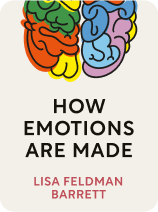

This article is an excerpt from the Shortform book guide to "How Emotions Are Made" by Lisa Feldman Barrett. Shortform has the world's best summaries and analyses of books you should be reading.
Like this article? Sign up for a free trial here.
What is emotional neuroscience? What does a modern theory of emotion tell us about neuroscience and emotions?
According to neuroscientist and psychologist Lisa Feldman Barrett, emotional neuroscience gives us a modern explanation of emotions, and many beliefs about how humans “feel” are outdated. Barrett’s new theory of constructed emotion reveals the neuroscience behind feelings and emotions.
Read on to learn how Barrett explains emotional neuroscience with her theory of constructed emotions.
Emotional Neuroscience, According to Barrett
In How Emotions Are Made, Lisa Feldman Barrett challenges many of society’s long-standing beliefs about emotions, calling into question everything from what emotions are, to where they come from and how to control them. Barrett’s research into emotional neuroscience demonstrates that:
- It’s impossible to tell how other people are feeling just by looking at their facial expressions or body language.
- Certain emotions exist in some cultures but not in others.
- Factors as diverse as what you eat and what movies you watch can affect how well you manage your emotions.
Through her studies in neuroscience, Barrett introduces a new theory of emotion, which posits that emotions are neither innate nor universal; rather, your brain constructs them. Contrary to popular belief, humans aren’t at the mercy of animal emotions. We play a role in creating our own emotions—and we bear the responsibility for our emotional behavior.
How Emotions Are Made uses emotional neuroscience to examine each element that the brain uses to make emotions (past experiences grouped together as “emotion concepts,” internal sensory input, and external sensory input), then puts them all together in a blueprint that explains how emotions are made. Barrett’s work in the field of emotional neuroscience shows the following:
- Emotions aren’t scientifically measurable; they’re mental concepts.
- Emotions aren’t universal across cultures.
- Feelings and emotions are not the same thing.
- Emotions are not reactions; they’re predictions.
- Emotions are not innate; they’re constructed.
- Emotion and illness are not as unrelated as they seem.
- Your emotions do not absolve you of responsibility for your actions.
| How Novel Is the Theory of Constructed Emotion? As Barrett herself recognizes, her theory of constructed emotion is controversial because it directly challenges the status quo. Barrett’s theory is indeed novel as a neuroscientific explanation of how the brain makes emotion out of cultural concepts. But when it comes to the psychological implications of her theory, some aspects of Barrett’s research are consistent with more established beliefs about emotion. For example, psychologist Daniel Goleman’s Emotional Intelligence, one of the most widely read books about emotion, asserts that there’s an area of the brain exclusively dedicated to emotions and that humans have two minds: a thinking one and a feeling one. In this sense, Emotional Intelligence expresses a more traditional theory of emotion that is directly at odds with Barrett’s theory of constructed emotion, which uses emotional neuroscience to explain that the entire brain is involved in the process of making emotions and that rational thoughts do not exist independent of feelings. Barrett and Goleman seem to agree, however, that past experiences associated with a particular emotion (which Goleman calls “emotional memories” and Barrett calls “emotion concepts”) largely determine the emotions someone experiences in the present. As a result, childhood experiences play a major role in an adult’s emotional well-being. Similarly, in The Body Keeps the Score, psychiatrist Bessel van der Kolk, like Goleman, states that the brain is divided into a reptilian brain, an emotional brain, and a rational brain. However, like Barrett, he also acknowledges that physical sensations in your body impact your emotions, and vice versa; in other words, your mind and body are inextricably connected. |

———End of Preview———
Like what you just read? Read the rest of the world's best book summary and analysis of Lisa Feldman Barrett's "How Emotions Are Made" at Shortform.
Here's what you'll find in our full How Emotions Are Made summary:
- A deep dive into what emotions really are and where they come from
- How some cultures have different emotions than others
- The difference between feelings and emotions






